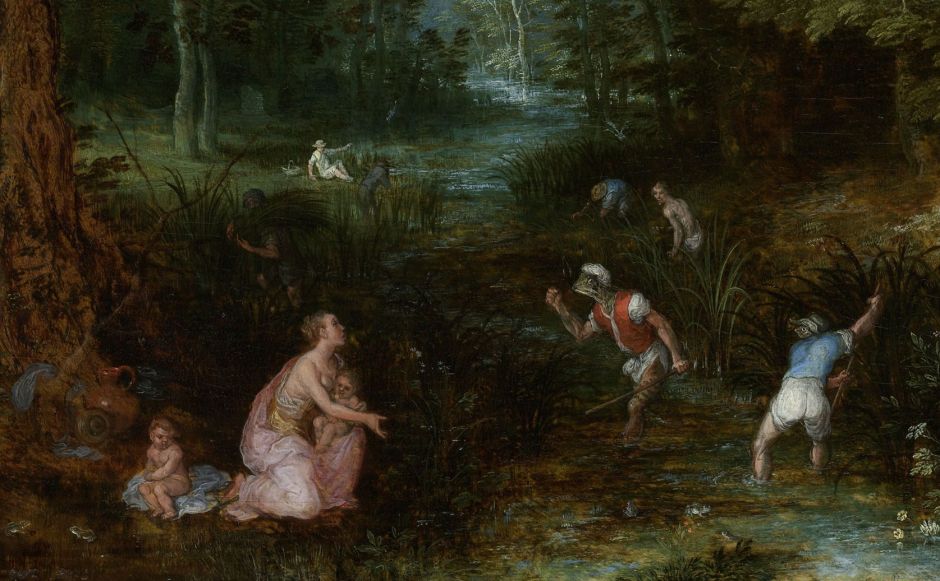Frogs and toads are small and humble creatures, hardly attractive themes for the artist. They’ve had their moments in paint though, through several myths and folk tales, in particular. In this and tomorrow’s articles I find some amphibians in paintings and try to explain how they came to be there.
For nearly two millennia, until the death of Classics in the twentieth century, one of the most popular myths was that of the birth of Apollo and Diana. Their mother was the goddess Latona (in Greek versions, Leto), whose worship centred on Lycia, at the western end of the south coast of modern Turkey. Her pregnancy was the result of another of Jupiter’s extra-marital relationships, so when she started labour, she fled from Juno to the countryside in Lycia, where it was very hot.
After she had delivered her twin infants and they had drunk her milk, she wanted to slake her thirst in a small lake among marshes, where local peasants were cutting reeds. She went down and was about to drink from the lake when those locals stopped her. The goddess told them that drinking the water was a common right, and that she only intended to drink and not to bathe in it. The locals continued to prevent her with threats and insults, then stirred up the mud on the bottom of the lake, to muddy the water. Latona’s thirst was replaced by anger, so she cursed them to remain in that pool forever, and transformed them into frogs.

Annibale Carracci’s Latona and the Lycian Peasants, probably from 1590-1620, is perhaps the first truly masterly painting of this myth. Latona is here placing her curse on the locals, and behind them one has already been transformed into a frog.

Jan Brueghel the Elder’s panel showing Latona and the Lycian Peasants from 1595-1610 is set in a dense forest where the locals are busy cutting reeds and foraging. As the detail below shows, the peasant closest to the goddess, brandishing his fist, is already rapidly turning into a frog. There are many other frogs around, including a pair at the bottom left corner, near the feet of one of Latona’s babies.


Although David Teniers the Younger doesn’t attempt to depict their transformation, his Latona and the Frogs from around 1640–50 shows a small army of frogs at the lower left.

Francesco Trevisani’s Latona and the Frogs from the late seventeenth or early eighteenth century is, like Tenier’s, painted in oil on copper, and includes two peasants in the midst of their transformation, and a very large frog who is big enough to scare one of Latona’s twins.

Johann Georg Platzer’s Latona Turning the Lycian Peasants into Frogs (c 1730) is another fine work on copper showing all the key elements of the story, including the rather macabre appearance of the peasants as they are transformed. His frogs are also massive relative to the size of the peasants.
Toads, on the other hand, have long been associated with dark arts and sorcery, and seen alongside the noted sorceress from classical myth, Medea.

In 1866-68, Frederick Sandys painted Medea at work preparing a magic potion. In front of her is a copulating pair of toads, and other ingredients. Behind her, in a gilt frieze, is Jason’s ship the Argo. I don’t know whether the toads offended the jury of the Royal Academy, but this wonderful painting was rejected when Sandys submitted it for exhibition.

When John William Waterhouse tackled the same theme in 1907, in his Jason and Medea, he opted for a single toad, behaving itself quietly on the floor. Medea is depicted as a sorceress, preparing perhaps the potion which Jason is to later give to the dragon. This time no offence was caused by the toad.

Bartolomeo Guidobono’s Medea Rejuvenates Aeson from about 1700 shows Medea, dressed in an unkempt and wild manner, in the act of rejuvenating Aeson. There’s a panoply of symbols associated with magic, including a snake and toad, large tomes of spells on top of which is a lizard, an open fire on a small stand, and an assortment of more normal animals including a dog, fox, and deer. The table in the background has further magical equipment, such as an orrery, and a bat is flying to the right of Medea’s head.

